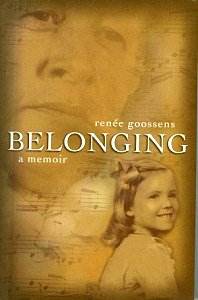Across nineteen chapters and 272 pages Renée
Goossens, the youngest daughter of the composer and conductor
Eugene Goossens (1893-1962) recounts her life story.
Renée is the daughter of Goossens' second
marriage. The first marriage was to Dorothy Millar known as 'Boonie'.
The children of that marriage were Anne, Julia and Jane. After
a divorce Eugene married Renée's mother, Janet Lewis. That
marriage also ended and Eugene then married Marjorie Foulkrod.
I do not want to steal the book's thunder but
here are a few of the musical and other milestones.
The book opens during Goossens' tenure with the
Cincinnati orchestra in the 1930s. He was there from 1931 to 1946.
The family moved to Australia in 1947. Musical references abound
including memories of reported Goossens' USA premiere of Pelléas
et Mélisande in 1931 in Chicago. The audience did not
like it. She tells of attending her father's concerts in Sydney
of casual domestic cruelties and of her first and captivating
visit to the opera (Meistersinger in Sydney) having had
her interest captured by hearing the prelude. She also happily
recalls her delight every time 'uncle' Charlie Groves called by.
There was an interlude in France and the return including a brief
reference to the night in 1946 when Goossens introduced Australian
audiences to Stravinsky's Rite of Spring.
Surrounded by music she inherited a love of classical
music which she has passed on to her son. She played the child
extra role as a street urchin in one of her father’s Sydney productions
of Boris Godunov. Then came her banishment to France to
exorcise her awful Australian American accent. Communication with
her father was virtually impossible. She learnt of her father's
family background from biographical notes in the programmes of
concerts she attended in Sydney and years later the tragedy of
the pornography scandal that blighted his career was revealed
to her through researching back copies of newspapers in Oxford..
Many of her formative years were spent in France.
Her recollections there include remembering seeing corpses of
Algerian Arabs on the streets of Paris in the 1950s. There is
also a vivid anecdote about Fischer-Dieskau giving her a whole
tube of cough sweets to quell the coughing that had punctuated
the first part of his concert and of taking her driving exam in
hair that had gone green after the wrong chemicals for colouring
had been used.
Tragedies continued with a fateful car accident
returning from a trip to the Cheddar Gorge. This resulted in eight
months in hospital during which she learnt, over the radio, of
her father's death and of her husband’s abandoning her for another
woman with whom he had a child. There were joys as well including
studying at long last at Westminster College in the mid-1960s
struggling to balance child care with work.
This book complements Carole Rosen's ‘The Goossens
- A Musical Dynasty’ (André Deutsch, 1993).
Lastly I note that this book has come to press
remarkably quickly having been completed in January 2003.
Since the 1990s her car accident injuries confined
her to a wheelchair and she now campaigns for enhanced mobility
for those in wheelchairs in Sydney. Her next project is a book
for parents on how to cope when their children suffer pain. Her
own experiences will I am sure lend this planned book a luminous
and caring practicality. Much of ‘Belonging’ is about pain but
also about joy ... joy as an eluate out of the experience of pain.
Rob Barnett
